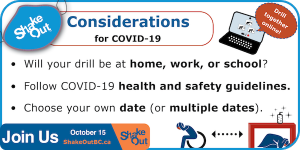
What to do Before an Earthquake
- Be prepared to be on your own for a minimum of three days or ideally up to one week by developing your emergency plan, putting together your emergency kit and connecting with your neighbours (PDF, 2.55MB).
- Take part in the Great British Columbia ShakeOut earthquake drill every October and practice what to do when the ground starts shaking.
What to do During an Earthquake
When you feel the ground shake, immediately drop, cover and hold on.
- Drop to your hands and knees. If you’re inside, stay inside – don’t run outdoors or to other rooms.
- Cover your head and neck with your arm and take shelter under a sturdy piece of furniture. If there is no shelter nearby, crawl to the nearest interior corner or wall while continuing to protect your head and neck.
- Hold on to your shelter, covering your head and neck until the shaking stops.

What to do After an Earthquake
- When the earthquake is over and shaking has stopped, count to 60 before getting up.
- Stay calm and move cautiously, checking for unstable objects and other hazards above and around you.
- Be aware of the potential for aftershocks – and continue to drop, cover and hold on every time you feel one.
This year, going the extra mile might mean participating at a different time or location, with physical distancing and other protective measures in place.
